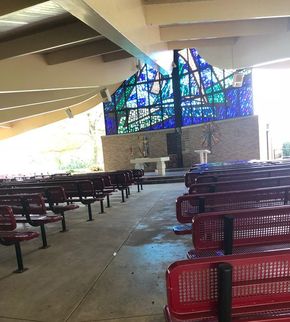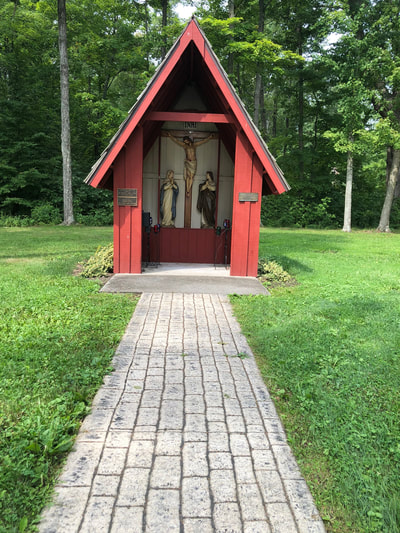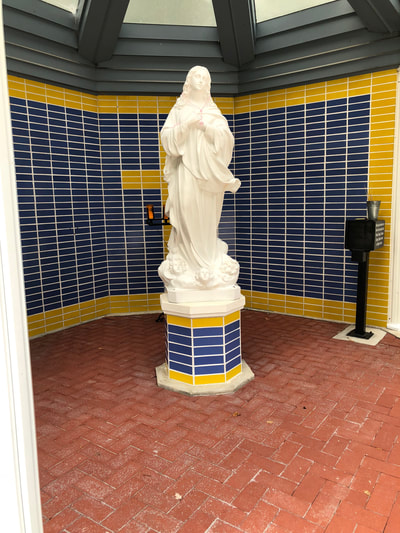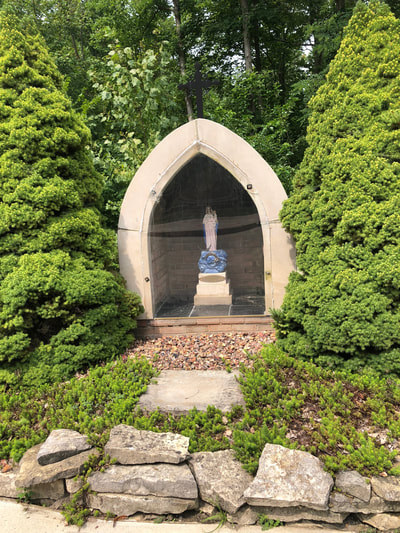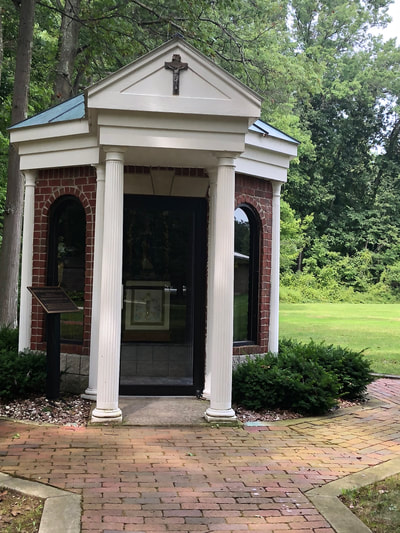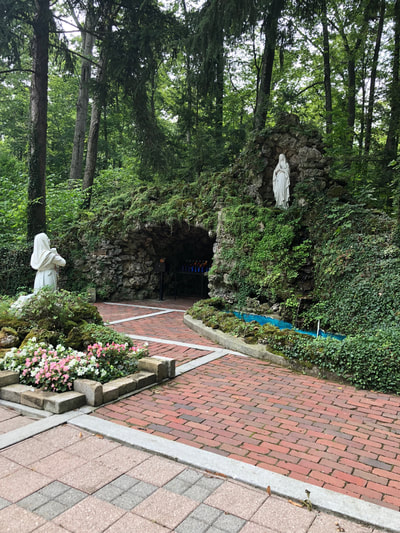The Sorrowful Mother Shrine
Bellevue, Ohio
Virtual Tour (2018): Claire Vaughn
In a rural northern Ohio town lies the oldest pilgrimage site dedicated to the Blessed Mother east of the Mississippi River. The Sorrowful Mother Shrine hosts more than 120,000 annual pilgrims.
The Grounds

The Sorrowful Mother Shrine is located in a rural area off of Route 269. Large trees line the property as one travels down the long driveway into the parking lot, passed a statue of The Sorrowful Mother.
The surrounding area is predominately German Catholic, as many immigrants settled in northwestern Ohio in the early 1800s.
The surrounding area is predominately German Catholic, as many immigrants settled in northwestern Ohio in the early 1800s.
Fr. Brunner and the Missionaries of the Most Precious Blood
 Photo of the Priests at The Sorrowful Mother Shrine courtesy of http://sorrowfulmothershrine.org/
Photo of the Priests at The Sorrowful Mother Shrine courtesy of http://sorrowfulmothershrine.org/
The Brothers who are stationed at The Sorrowful Mother Shrine are members of the Missionaries of the Precious Blood, which was founded in Italy in 1815. St. Gaspar del Bufalo, the founder of the order, had a great devotion to the Divine Blood of Jesus. His goal was to form a special group to promote the Blood of the Savior and engage in evangelization, missions and reconciliation, and helping those in need of religious education. Fr. Francis de Sales Brunner joined the order shortly after it was formed. He spotted a wooded area while living in Northwestern Ohio. He decided to build a small red brick chapel to honor The Sorrowful Mother, as she guided him and the other priests from Germany and Switzerland to the United States. Quickly, the Shrine became very popular among the other German Catholic settlers that came to the area.
Later on, in 1870, a new, larger chapel was constructed. But, on the Feast of the Assumption in 1912, the chapel caught fire and burned down and with it the original wood carved statue that Fr. Brunner brought from Germany. Within two years, however, a new chapel was constructed in its place adorned with beautiful stained glass and a bell tower. This chapel still stands today. Later, an outdoor chapel, known as the the Pieta Chapel, was built and dedicated in 1968 to accommodate more pilgrims visiting.
Fr. Brunner chose the title, "Our Lady of Sorrows," because he wanted to thank Mary for all the sorrows and suffering that she endured with Jesus during His Passion and Death.
Later on, in 1870, a new, larger chapel was constructed. But, on the Feast of the Assumption in 1912, the chapel caught fire and burned down and with it the original wood carved statue that Fr. Brunner brought from Germany. Within two years, however, a new chapel was constructed in its place adorned with beautiful stained glass and a bell tower. This chapel still stands today. Later, an outdoor chapel, known as the the Pieta Chapel, was built and dedicated in 1968 to accommodate more pilgrims visiting.
Fr. Brunner chose the title, "Our Lady of Sorrows," because he wanted to thank Mary for all the sorrows and suffering that she endured with Jesus during His Passion and Death.
Pilrgrimage Center
The Pilgrim Center is the first building by which one is greeted. It's a long, gray building that reads "Pilgrim Center" right on the front of it. Inside, there are bathrooms, the business office, a cafeteria, a sitting area, and the gift shop. This is a great place to take a break from walking and exploring to sit and relax. There are religious magazines and books for reading, as well as pictures and a bust of Fr. Brunner. A large stained glass window sits towards the front of the sitting area, brightening the room. The folks in the business office are very helpful if one has any questions or needs some assistance. Next to the office is a wall of brochures and newsletters. This is where the self-guided tour brochure is located.
Tour of the Grounds
|
There are two chapels on the grounds of The Sorrowful Mother Shrine. One is the Sorrowful Mother Shrine Chapel, wherein Mass is celebrated everyday throughout the year. This church is considered the heart of the Shrine. The beautiful stained glass windows portray Mary's role in the church and in Jesus' life.
|
|
The other Chapel is the Pieta Outdoor Chapel, which was built in 1968 to accommodate an increasing amount of pilgrims, especially those from Toledo, Cleveland, Youngstown, Detroit, Pittsburgh, and Windsor, Ontario. Since this chapel is outdoors, Masses are held on Saturdays and Sundays from May through September.
|
There is more to the site than the two chapels. The rest of the Shrine is made up of 120 acres of winding paths amidst tall, vibrant trees and flowers. Within these relaxing woods are 32 different grottos and religious statues. Each grotto is dedicated to a certain saint or a mystery of Christ's or the Blessed Virgin's life. Many of these statues and grottos were left or donated to the Shrine by pilgrims, usually to honor their patron saint. One may visit and pray at the grottos or hold special services at the grottos for a specific devotion. There are even plastic rosaries provided at many of the statues and grottos to assist in prayer and devotion.
This is a self-guided tour. One can, however, schedule a tour with one of the priests or Rose Dick, the woman who runs the gift shop. There are brochures available inside the Pilgrim Center which display a map of the grounds with corresponding names of each statue or section.
This is a self-guided tour. One can, however, schedule a tour with one of the priests or Rose Dick, the woman who runs the gift shop. There are brochures available inside the Pilgrim Center which display a map of the grounds with corresponding names of each statue or section.
Your browser does not support viewing this document. Click here to download the document.
Click each picture below and read the captions to learn more about the different statues and grottos at the Shrine.
The Gift Shop
|
The Shrine also has a gift shop located in the Pilgrim Center. Before you walk in, there's a bulletin board with pins asking pilgrims to place a pin in the location from which they came. It's a great way to demonstrate the breadth of pilgrims that travel to the Shrine. The gift shop itself is one large room with bookshelves to the left, large statues to the right, the checkout counter in the front, and tables of other religious items for sale, like prayer books, rosaries, jewelry, and more.
|
 Picture taken from The Sorrowful Mother Shrine Newsletter Summer 2018
Picture taken from The Sorrowful Mother Shrine Newsletter Summer 2018
There is a lovely woman named Rose Dick who has run the gift shop for 17 years. According to Fr. Kramer, "God is good and His goodness shrines forth through good people like our own Rose Dick." She is retiring from her duties at the gift shop this year. However, she will not be retiring from the Shrine. She has been getting involved with other aspects of the Shrine life. She has already become the Shrine's premier tour guide, driving pilgrims around in the golf cart.
Events at the Shrine

The Sorrowful Mother Shrine has Masses and Confessions everyday during the year in the Sorrowful Mother Chapel. During the Summer they have Mass outside at the Pieta Chapel, weather permitting.
Along with daily Masses and Confessions, the Shrine also has Ethnic Days. These are specific Sundays throughout the summer to celebrate pilgrims of a specific ethnicity as well as their culture and traditions. During these days, the Mass is said in their native language. Then, the group of pilgrims process around the Shrine, usually visiting pertinent statues or grottos. For example, on Hispanic Sunday, Mass is said in Spanish and then a group of pilgrims process around the Shrine carrying a stature of Our Lady of Guadalupe while singing and praying in Spanish. Later on, they do traditional dances in traditional garb. This is a series of events that the pilgrims seem to really enjoy.
Along with daily Masses and Confessions, the Shrine also has Ethnic Days. These are specific Sundays throughout the summer to celebrate pilgrims of a specific ethnicity as well as their culture and traditions. During these days, the Mass is said in their native language. Then, the group of pilgrims process around the Shrine, usually visiting pertinent statues or grottos. For example, on Hispanic Sunday, Mass is said in Spanish and then a group of pilgrims process around the Shrine carrying a stature of Our Lady of Guadalupe while singing and praying in Spanish. Later on, they do traditional dances in traditional garb. This is a series of events that the pilgrims seem to really enjoy.
Miracle Stories
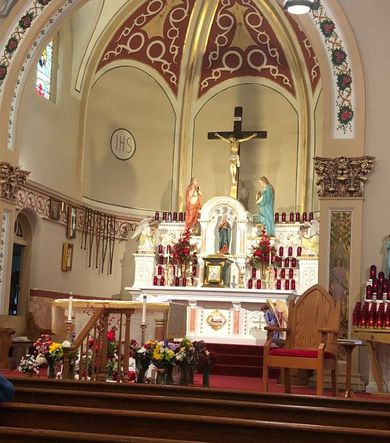
The Shrine has miracle stories attached to it, including multiple stories of healing as a result of visiting the Shrine. Although none of these claims have been authorized by the Catholic Church, the miracle stories are fundamental to the identity of the Shrine. Pilgrims come to experience healing of different types: emotional, mental, and even physical. Throughout the Shrine, there are crutches and casts that have been left by pilgrims who have received healing for their physical ailments after visiting the Shrine. These can be seen lining the wall on the altar in the Sorrowful Mother Chapel and in the hallways of the Pilgrim Center.
Fr. Kramer
|
Fr. Scott Kramer, C.PP.S. is the director of The Sorrowful Mother Shrine. Growing up in a German Catholic Community just down the road, the Shrine has been a part of his life for quite a while. He has served as the director for 6 years now. For Fr. Kramer, Shrines are unique places which are necessary for people to slow down, walk through, and heal.
|
The Sorrowful Mother Shrine demonstrates the connection between pilgrims and materiality. Through this link, this site and others like it reflect an important element of Catholicism, honing in on the breadth of pilgrims and their journeys, both physical and spiritual. The statues and grottos brought and donated by pilgrims, demonstrate this link between spirituality and materiality. More than this, other pilgrims come to visit these statues and shrines which have been left by others from all over the world. This Shrine exemplifies diversity and universality through the donations of statues from all around the world, the "Where are you from?" bulletin board, and finally the Ethnic Day events. The Shrine offers opportunities for pilgrims to pray, heal, and experience Catholicism all in one place.





